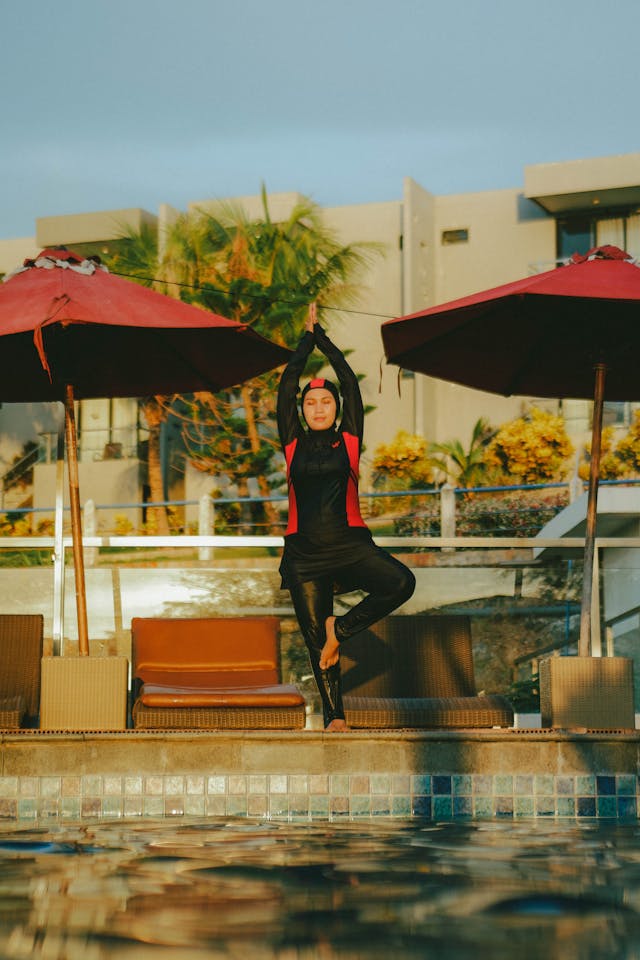Introduction to Yoga
Table of Contents
Yoga, an ancient practice rooted in over 5000 years of history, is more than stretches and poses; it’s it’slistic journey of physical health, mental clarity, and spiritual growth. Whether you’ryou’reginner or a seasoned yogi, finding the right yoga class can be a transformative experience.
Types of Yoga
Yoga comes in various forms, each offering unique benefits and challenges. Understanding the different types can help you choose the best fit for your needs.
Hatha Yoga
Hatha Yoga is a branch of yoga focusing on physical postures (asanas), breath control (pranayama), and meditation. It is one of the oldest and most traditional forms of yoga, often considered a foundational practice that emphasizes physical health and mental clarity. The primary goal of Hatha Yoga is to prepare the body and mind for deeper spiritual practices such as meditation.
In a typical Hatha Yoga class, practitioners perform a series of asanas designed to align and calm the body, mind, and spirit in preparation for meditation. These asanas vary in difficulty and can be modified to accommodate practitioners of all levels. Breath control exercises are also integral to the practice, aiding in the control of the vital energy within the body.
Hatha Yoga is well-regarded for its benefits, which include improved flexibility, strength, endurance, and stress reduction. It is also used as a therapeutic practice to help with various health conditions such as back pain, arthritis, and anxiety. The slow pace and focus on static poses make it particularly accessible to beginners, offering a gentle introduction to the wider practices of yoga.
Vinyasa Yoga
Vinyasa Yoga is a dynamic style of yoga that is characterized by a flowing sequence of yoga postures linked with breath. This style is sometimes referred to as “flow” yog”, due to the smooth way the poses run together and become like a dance. The term “Viny”sa” its”lf means “to p”ace in a special way,” ref”rring to the alignment of movement and breath.
In Vinyasa Yoga, each movement is synchronized with the breath. Practitioners inhale and exhale as they move from one pose to another in a fluid, continuous motion. This creates a meditative flow that can help to improve focus and concentration while also building physical strength and flexibility.
Because of its adaptable nature, Vinyasa Yoga classes can vary widely in pace and intensity. Some classes might be fast-paced and challenging, designed to build heat and energy in the body, while others may be slower and more focused on stretching and relaxation.
This type of yoga appeals to those who are looking for a vigorous workout that also promotes mental calmness and relaxation. It’s especially popular among those who enjoy a sense of rhythm and movement in their exercise routines. The continuous flow of Vinyasa also aids in improving cardiovascular fitness, making it a comprehensive mind-body workout.
Ashtanga Yoga
Ashtanga Yoga is a highly structured and intense form of yoga that involves a specific sequence of postures linked together by breath and movement. It’s because of its rigorous style and the discipline it demands from its practitioners. The term “Asht”nga” lit” rally means “eight” limbs” in “Sanskrit, which refers to the eight limbs outlined in the Yoga Sutras of Patanjali that form the foundation of the practice. These include ethical guidelines, personal disciplines, posture practice, breath control, sensory withdrawal, concentration, meditation, and absorption.
The Ashtanga Yoga system is traditionally taught in series, beginning with the Primary Series, designed to detoxify and align the body. This series is followed by the Intermediate Series and several Advanced Series, each level introducing more complex poses that build on the previous series. The sequences are not merely physical exercises but are meant to purify and control the mind and body.
A key component of Ashtanga Yoga is the Vinyasa method, where each movement is synchronized with breath in a process called “break” or h-synchronized movement.” Thi” method is intended to create internal heat, which leads to purification of the body through increased circulation, and sweating.
Ashtanga Yoga is also characterized by using Drishtis (focused gaze points) and Bandhas (energy locks), which aid in concentration and energy flow through the body. It is typically practiced in a quiet, disciplined environment without music, to deepen focus and meditation.
This yoga style appeals to those looking for a challenging physical practice and strong mental discipline. It is demanding but can be very rewarding, leading to significant improvements in physical strength, flexibility, and mental focus.
Related Article: Restorative Yoga Near Me
Finding Yoga Classes
Finding the right yoga class can significantly enhance your practice and overall experience. Here are some steps and tips to help you find yoga classes that suit your needs:
- Determine Your Yoga Style: Decide which type of yoga you want to pursue. Hatha Yoga is great for beginners due to its slower pace, Vinyasa Yoga is good for those who want a more dynamic workout, and Ashtanga Yoga suits those seeking a more rigorous and structured practice. Knowing what style you prefer will help narrow down your options.
- Research Local Studios: Start by searching for yoga studios in your area. Use online search engines, apps like Yelp or Google Maps, and social media platforms to find nearby locations. Check their schedules to see if they offer the type of yoga you want.
- Check Class Offerings and Schedules: Once you see some studios, visit their websites to check the class schedules and descriptions. If you prefer, look for beginner classes or specific styles like Vinyasa or Ashtanga.
- Consider Online Classes: If you prefer practicing at home or have limited options nearby, consider online yoga classes. Many websites and apps offer a range of styles and class lengths at various skill levels. Platforms like YouTube also provide free yoga classes.
- Read Reviews and Testimonials: Read what other people are saying about the studios or online classes you’re interested in. Reviews can provide insight into the quality of instruction, class atmosphere, and overall satisfaction of other students.
- Visit the Studio: If possible, visit the yoga studio in person. This can give you a feel for the environment and possibly meet the instructors. Some studios offer free first-class or introductory discounts for new students.
- Ask About Qualifications: Ensure the instructors are certified and have undergone proper training, especially if you consider more physically demanding styles.
- Assess Accessibility and Amenities: Consider the location, parking, class times, and other amenities like changing rooms or available yoga mats. These factors can significantly influence your overall experience.
- Try a Few Classes: Don’t hesitate to try several classes or studios before settling on one. Your experience in the class is the best way to determine if it fits you.
Related Article: Naked Yoga: A Liberating Approach to Wellness and Self-Acceptance
Community Boards
Community boards in local community centers, libraries, and coffee shops are valuable resources for discovering local activities and services, including yoga classes. These boards often feature postings from local yoga instructors or small studios that may not have a solid online presence, offering unique and intimate class experiences.
Benefits of Using Community Boards to Find Yoga Classes
- Local Focus: These boards often highlight local offerings, making finding yoga classes near home or work more accessible. This can be particularly useful for those looking to join courses contributing to the local community.
- Diversity of Options: Community boards might display various yoga styles and instructor backgrounds, providing a broader selection than what you might find in more commercialized or mainstream settings.
- Personal Touch: Classes advertised on community boards can have a more personal, grassroots feel, often with smaller classes that allow for more personalized instruction.
- Affordability: Community-run or smaller yoga classes tend to be more cost-effective, and sometimes even free, as they may be subsidized by community organizations or run on a donation basis.
- Community Connection: Joining a yoga class through these boards can help foster a sense of community. It’s Easy to meet neighbors and engage with your local area meaningfully.
Tips for Using Community Boards
- Visit Regularly: New postings can appear frequently, so checking these boards regularly is beneficial to catch new classes as they are announced.
- Contact Information: Always check for contact details on the postings to inquire directly about the class and its schedule and to confirm any details, such as the venue or cost.
- Explore Different Locations: Different boards might have different offerings. Check boards in various local venues like libraries, community centers, and even local health food stores.
- Engage with Community Events: These boards often advertise more than yoga classes. They might also list community events where you can learn more about health, wellness, and other activities.
Class Level
Ensure the class matches your experience level. Most studios offer classes from beginner to advanced levels, helping you grow at a comfortable pace.
Instructor Credentials
A qualified instructor can make a significant difference. Look for teachers with certified training and good student feedback.
Preparing for a Yoga Class
Preparation is key to enjoying and benefiting from your yoga class.
Related Article: Free Online Yoga Classes
What to Bring
Typically, you’lyou’ll a yoga mat, water bottle, and perhaps a towel. Some studios provide mats, but bringing your own is more hygienic.
What to Wear
Wear comfortable, stretchable clothing that allows you to move freely. Breathable fabrics are best, as they help keep the body cool during practice.
Benefits of Regular Yoga Practice
Practicing yoga regularly can significantly improve your quality of life.
Physical Benefits
Regular yoga practice enhances flexibility, strength, and balance. It also contributes to improved cardiovascular health and overall physical endurance.
Mental Benefits
Yoga is known for its ability to reduce stress and anxiety. It promotes a more relaxed mind and helps to maintain mental health.
FAQs
What is the Best Yoga for Beginners?
For beginners, Hatha Yoga is often recommended because of its slower pace and focus on basic postures and breathing techniques. It provides a solid foundation for learning yoga’yoga’samental principles and helps new practitioners build confidence and comfort with the poses. Another good option for beginners is Iyengar Yoga, which emphasizes alignment and precision in poses, often using props like blocks and straps to help maintain balance and deepen poses without strain.
How Many Times a Week Should You Do Yoga?
The frequency of yoga practice can vary based on personal goals, schedule, and physical condition. Generally, practicing yoga two to three times per week is beneficial for beginners to build strength, flexibility, and familiarity with the poses. As you become more comfortable and your body adapts, you might increase the frequency to daily practice, which can enhance the physical and mental benefits.
How Do I Cancel My Yogabox Membership?
To cancel a membership like Yogabox, you would typically follow these steps:
Check Your Membership Agreement: Review the terms of your membership for specific details on the cancellation policy.
Contact Customer Service: Reach out to Yogabox directly through their official website, customer service email, or phone number. They can guide you through the cancellation process.
Follow Specific Instructions: You may need to fill out a form or send a written notice. Be sure to get confirmation of the cancellation to avoid future charges.
Do You Pay for Yoga at PureGym?
At PureGym, yoga classes may be included as part of your membership, or there might be a fee for specific classes. This can vary by location:
Included in Membership: Some memberships offer classes, including yoga, as part of the monthly fee.
Additional Fee: Some specialized classes or sessions led by external instructors might require an additional fee.
To get the most accurate information, check directly with your local PureGym or visit their website to see the class timetable and whether there are any additional costs associated with yoga classes.
Conclusion
Yoga is a deeply enriching practice that benefits mind, body, and spirit. Finding the right class is essential to fully experience all that yoga has to offer. Consider your options, try different styles, and commit to a practice that feels right for you.







